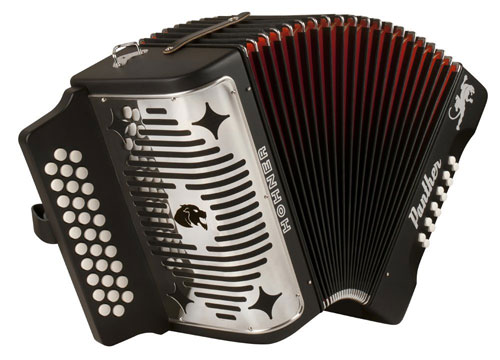By Llúcia Ventura.
The diatonic accordion (also known as button accordion) belongs to the reed organ family of wind instruments. Its mechanism is very simple. When the buttons or studs are pressed, the air inside the bellows vibrate the reeds, producing the sound. These metal reeds vibrate as air passes through them, and no other elements are needed. That is why they are known as free reeds.
The accordion was born in Austria around the year 1829, and it spread rapidly across Europe, reaching the Americas and Russia. It seems like the precursor of the accordion are the mouth organs, that came from Asia. These are the first instruments known that used a free reed to produce sounds.
The accordion was patented by Demian, a Viennese luthier. Since its conception, the accordion didn’t evolve very much, until the year 1880 in which accompaniment buttons were added. The possibility of playing a melody with a chord accompaniment (that’s where the name accordion comes from) allowed the accordion to be introduced to different folk traditions. This is how it became a basic instrument for popular dances. It was also known as the piano of the poor. With time, numerous technical improvements were added, giving way to very diverse models. The name diatonic accordion comes from the fact that every button plays two notes, depending on which direction the bellows are playing.

On the right, the accordion has the melody buttons, arranged in one, two or three rows. On the left there are 2 to 16 buttons that play the accompaniment. In this way, the right hand plays the melody and the left hand plays the accompaniment and moves the bellows.
As mentioned earlier, the accordion spread rapidly across Europe, becoming very popular, especially in Central and Eastern Europe. It arrived to Spain, becoming very important in the Basque region (read A Little History of the tritikitixa).
In Catalonia (northeastern Spain) it spread across the Pyrenees region. In rural areas, accordion players were in charge of performing at traditional dances.

In the last decades, the accordion, very little known by the majority of the population, is having a comeback: accordion player encounters and summits, and other events have generated a lot of interest for this instrument. There are many musicians who now play the diatonic accordion, guaranteeing its continuity and exposure.
Although the accordion is an instrument that lends itself nicely for dance music, we can now find many traditional music groups who take advantage of its characteristics and, overall, its rich sound to play all kinds of pieces. That is why the accordion is no longer considered exclusively as a dance instrument.
(Translated by Angel Romero. Courtesy of Arca de Música)
(headline image: Hohner Corona Xtreme II accordion, 34 button)


